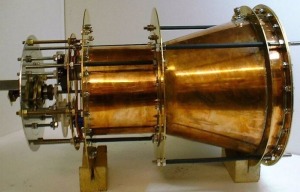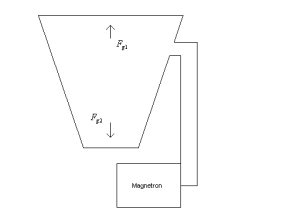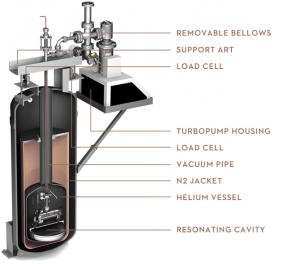The EmDrive
At this point, after all my previous posts, I wouldn’t be surprised if some readers were wondering whether PNN really exists or it’s rather one of the many scams in the scientific world.
The easiest way to convince everyone would be, of course, a public demonstration with the participation of scientific community that can validate ASPS‘s claims. Although the Association itself aims for such public event the technology behind PNN is not ready for a demonstration yet, because Laureti wants first to enhance TDS VF2 thrust to at least 1.1g (prototype take-off) . In order to do this TDS needs to be 32 times more powerful than now and ASPS is facing all the correlated technical difficulties to achieve this result.
While we wait that the exhibition dispels all doubts, we could find another way to sense that there’s definitely something behind PNN: I’m talking about the similar technologies that are emerging around the world.
In 2001 British aerospace engineer Robert Shawyer invented an electromagnetic propellant-less thruster called EmDrive, which works by injecting microwaves inside a metallic hollow cone using a magnetron. As the cone shape acts as a wave-guide, the group velocity of the waves impacting on the large end is higher than that of the waves impacting on the narrow end; this difference of speed directly affects the radiation pressure exerted on both ends. If we call F1 the force exerted on large end and F2 the force exerted on narrow end, we can see that F1 is higher than F2. This means that the whole structure will be pushed in the direction of F1, with a little drag caused by F2 which pushes in the opposite direction. Usually the radiation pressure wouldn’t be noticeable but inside the EmDrive it is amplified through the phenomenon of resonance. For this reason the scientific community has baptized the device as Radio Frequency resonance cavity thruster.
The electromagnetic forces F1 and F2 inside the EmDrive cavity
In 2014 NASA tested Shawyer’s device in a vacuum chamber and reported that a thrust of 91.2uN at 17W of input power has been observed [1]. Even if this measure is close to instrument sensitivity threshold (thus with an high risk of measurement error), it is enough to let NASA’s fantasy run wild. One of Agency‘s scientists, Harold White, speculates that the thrust is generated because microwaves push against quantum vacuum virtual particles inside the resonant cavity[2]. Another researcher external to NASA, Dr. Fernando Minotti, speculates that the thrust may be explained by certain scalar tensor theories of gravity[2]. In practice, every EmDrive observer tries to explain how it works without daring to affirm that this kind of device violates Newton’s third law of motion, because it would be like swearing for a scientist. Rather they chose to set up complex explanations that contemplate advanced theoretical physics, losing sight of the implications of the EmDrive existence. ASPS instead has always written that the Third Law does not apply in electrodynamics and it’s thank to this understanding that PNN-E is heading to take-off. If we think about it for a moment, when Newton formulated his laws electromagnetism wasn’t discovered yet: why should we say they’re valid in this field?
Right here on Neo Leges Motus Emidio Laureti has commented about EmDrive: he writes that all parties involved actually don’t have a clue of what is happening inside the device. To make a comparison it’s like as if they were trying to build a rocket ignoring the action/reaction principle: without knowing the real phenomenon that occurs inside the EmDrive the measurements will utterly confuse researchers because their value will vary from time to time. For this reason, the gap between EmDrive and PNN-E is unbridgeable and ASPS is light years ahead in the research (in the right direction).
Why EmDrive is similar to PNN-E?
Because the magnetron is basically an antenna that emits electromagnetic waves, which interact with the metallic mass of the cone pushing it in a given direction. The macroscopic difference is that PNN-E doesn’t need a resonant cavity to exploit EM field because the thrust is induced within the dipole region. In fact, while EmDrive magnetron transmits power toward the cavity, in PNN-E Laureti struggles to convey as much power as possible nearby the dipoles instead of irradiating it. Another big difference is that while PNN-E is a reactionless drive, EmDrive doesn’t eliminate completely the reaction force (F2).
In 2006 the chemical engineer Guido Fetta realized his own variation of EmDrive, called Cannae Drive. The working principle is the same but Fetta, like White, believes that the thrust is produced by quantum void fluctuations. The architectural difference is that the cavity is a cylinder with the insides coated of reflecting materials of different refractive indexes. NASA tested Cannae Drive as well, reporting a thrust of 25uN [1].
NASA experimental setup for Cannae Drive
What is strange is that Fetta has declared that an inner slotting is crucial for the thruster to work but in NASA’s “null test” (without the slotting) the device has produced thrust nevertheless. This could make us think to the unpredictability of results theorized by Laureti or to the measurement errors due to the microscopic thrusts involved.
However, the point is that an authority of NASA’s caliber has confirmed an anomalous thrust production in propellant-less devices that work using electromagnetic waves. Indirectly, they’ve validated what ASPS has been saying for twenty three years.
1. Anomalous thrust production from an rf test device measured on a low-thrust torsion pendulum



Parole di Laureti su cobraf: ” ben sai che la ricerca del “the Sacred Grail of propulsion”
essendo un Graal è impresa vana
e distruttiva per chi insiste
dedicati alla fuf e sarai di certo più contento e più vivo 🙂 ”
http://cobraf.com/forum/PostsByAuthor.php?authorid=4159
con tutta evidenza sia io che Laureti siamo masochisti 🙂
mi piacerebbe avere il tuo indirizzo mail privato. ciao.
LikeLike
Egregio
ben sai che ormai su cobraf si ca**eggia essendo purtroppo venuta meno ogni consistente possibilità
che la fuf by Rossi abbia un qualunque fondamento oggettivo.
LikeLiked by 1 person
si e’ vero, peccato pero’, anche io ci avevo creduto all’inizio.
Il prossimo Graal e’ il polywell, dopo la pnn, of course.
LikeLike
http://www.wired.co.uk/news/archive/2015-07/24/emdrive-space-drive-pluto-mission
Per emdrive ci vogliono 18 mesi fino a plutone, con la pnn asps ci vuole 1 mese …?
LikeLike
Ciao Valerio, articolo interessante. Stanno facendo ipotesi di viaggi con un motore a bassa efficienza, come era la PNN dieci anni fa e se non azzeccano il vero principio che lo fa muovere difficilmente si schioderanno da quei valori di spinta.. In più hai notato che nessuno ha ancora fatto l’associazione motore EM = possibilità di visitare più corpi celesti e tornare a casa?
Comunque mi preoccupa il fatto che dopo un simile eco mediatico da parte della NASA la PNN dopo il suo debutto potrebbe diventare “L’EmDrive dell’ASPS”.
LikeLike
Ciao Sergio, em drive sarebbe un termine generico di un tipo di propulsore, poi dato ad uno specifico device, fraudolentemente, aggiungo, perche’ anche la pnn asps e’ un em drive. Il rischio di confusione e’ alto.
Si potrebbe dire sempre nasa emdrive e asps pnn per essere chiari.
LikeLike
Sì è vero, il nome che gli ha dato Shawyer è generico e va bene per tutti i dispositivi come la PNN ed motore di Ensle. Andrà sempre fatta la distinzione fra PNN ed EmDrive.
LikeLike
Egregi
inserisco qui una mia replica ( su EMdrive e pnn) su It.politica e crosspostata poi su it.discussioni.misteri e free.it.scienza.fisica con il titolo “si aprono/chiudono le porte del sistema solare”
Il giorno mercoledì 29 luglio 2015 14:18:55 UTC+2, GiOvAnNi ha scritto:
> On Wednesday, July 29, 2015 at 2:05:30 PM UTC+2, KingDementor wrote:
> > On Wednesday, July 29, 2015 at 1:54:29 PM UTC+2, GiOvAnNi wrote:
> >
> > >
> > > IMVHO, e’ l’ennesima cazzata del propellantless thruster.
> >
> > Da profano mi verrebbe da pensare la stessa cosa, il fatto è che non è
> > una cosa venuta fuori ieri, sono anni che se ne parla e comunque viene
> > da ambienti accademici, non dal garage del laureti di turno…
>
> Guarda che in questo caso Laureti e’ d’accordo con me (che sono peraltro nel
>gothalist dell’asps perche’ Emidio pensa che io sia un’altra persona): quella
>roba li’ non ha alcuna base per funzionare.
ho pazienza per ripetere a non udenti e vedenti quello che è noto da più di un secolo….
La problematica dell’EMdrive ha due diciamo corni
1)il principio di azione e reazione non ha alcun senso in elettrodinamica e non sono io ad averlo detto per primo http://www.asps.it/azione.htm …. la cosa non è affrontata in genere e evitata perché la massa dei fini teorici pur sapendo che non ha senso il III di newton in elettrodinamica, non sanno come si viola operativamente …. e quindi dovrebbero ammettere di NON essere fisici perché la fisica è la scienza del “come” 🙂
2) dal corno 1) segue quello n.2 che si può brevemente definire cosi : non capendo in pratica un kazzo circa le operazioni per violare il III la massa asinina che specula sull’EMdrive pensa che violando il principio di azione e reazione si mandi a cagare pure la conservazione della qdm (quantità di moto)…
balle … Moretti lo dice chiaramente in http://www.asps.it/azione.htm.
la qdm è salvata dal campo elettrodinamico stesso .
Aggiungo solo che probabilmente l’EMdrive funziona violando il III come fa la pnn ( ci sono varianti pure della pnn) …. ma la massa ortodossa non vuole rinunciare al satana delle cappelle consolidate in elettrodinamica classica … per cui
potranno stare a guardare per qualche migliaio di anni l’EMdrive senza capire un kazzo di come veramente funziona 🙂
Vi potrei convincere facilmente circa i principi di funzionamento di pnn e emdrive … ma devo far prima volare la mia pnn per dare in testa il pendolo a cucù alla massa di idioti più o meno anonimi elencati in http://www.asps.it/gotha.htm.
E.Laureti
ps: Cesaretti se sei finito nella gothalist da innocente vedila come un danno collaterale non nocivo (non ho alcuna difficoltà a riconoscere i miei errori) … se farò un po di pippi con la pnn pagherò qualcuno per rintracciare tutti i rettili anonimi elencati in http://www.asps.it/gotha.htm che hanno attuato con la pnn la tattica dello smerda e fuggi in rete da quasi 20 anni….
voglio le palle dell’anonimato di sargassen e di molti altri su un ceppo 🙂
LikeLike
Tra l’altro Shawyer e Fetta hanno preso due strade diverse per spiegarne il funzionamento. Uno parla di pressione di radiazione e l’altro di vuoto quantico.. ma la forza di Lorentz non dovrebbe essere una delle prime cose a cui pensare? Oppure le varianti PNN possono funzionare anche in altra maniera?
LikeLike
Quello che posso dire è che “Varianti” per la pnn significa “iterare” il ciclo di spinta con la stessa energia …. ma non è facile perché l’impedenza aumenta … e non esiste una strumentazione valida di controllo per migliorare diversi problemi che si presentano.
Quello che dicevo nel precedente post è che esistono cappelle formidabili a livello sperimentale in elettrodinamica classica e che non se ne discute per non turbare uno status quo che si ritiene assodato.
Ora mantenedosi questi presupposti di base quelli che si dedicano all’EMdrive non capiranno mai nulla
del suo reale funzionamento e potranno ottenere miglioramenti solo in modo casuale.
In passato ho cercato di discuterne in Usenet ricevendo solo silenzio ,insulti e comici sputtanamenti (mi riferisco a E.Fabri) http://www.asps.it/contesto.htm .
Ora ho deciso di assecondare la loro pazzia dato che sostanzialmente lavora per l’inaccessibilità della
pnn al difuori dell’asps. 🙂
Vulgus vult decipi ergo decipiatur
E.Laureti
LikeLike
Hai ragione, se non cambieranno forma mentis non andranno lontano con l’EmDrive.. leggevo che Shawyer propone degli spazioplani dimostrativi equipaggiati con il suo motore e teorizza persino una sonda interstellare che raggiungerebbe 0.64c in dieci anni… ma tutto senza neanche sapere cosa succede nel dispositivo! Inoltre scopro che le frequenze sono “bassine”: 500-900Mhz non è un po poco per la propulsione EM?
LikeLike
non posso dare tutti i dettagli cmq …in teoria … ogni frequenza andrebbe bene …. però le dimensioni di un prototipo sono funzione della sua lunghezza d’onda . A 144 mhz sono circa 2 metri … e ho problemi di alloggiamento sperimentale per frequenze basse (dimensioni del lab) e di eccessiva miniaturizzazione per frequenze elevate.
Cmq..cmq… con un bel po di pippi si risolverebbero tecnologicamente molti di questi problemi … e non me lo posso permettere.
Saluti
LikeLiked by 1 person
rationalwiki is not the best source on emdrive.
this reddit gather many facts
https://www.reddit.com/r/Futurology/comments/34cq1b/the_facts_as_we_currently_know_them_about_the/
there is a wiki
http://emdrive.wiki/Main_Page
Shawyer have a FAQ
http://emdrive.com/faq.html
and many papers on his site
Nextbigbuture have nice articles, updated regularly
http://nextbigfuture.com/search/label/emdrive
(and there is me, my scoop.i and twitter… noisy I admit)
about theory, beside shawyer there is MiHsC which is interesting, beyond Emdrive&al
http://physicsfromtheedge.blogspot.co.uk/2015/05/emdrive-whence-motion.html
http://physicsfromtheedge.blogspot.co.uk/2014/01/mihsc-101.html
I don’t know if your ASPS can be explained in MiHsC framework too…
LikeLike
Hello Alain, sorry for the delay in publication but your comment for some reason was marked as spam and I didn’t notice it.
Thanks for the links, I’ll use them if I’ll write again about EmDrive.
I didn’t know about MiHsC theory.. I think PNN-E is simpler than that: it’s more like a loophole in electrodynamics theory.
LikeLike